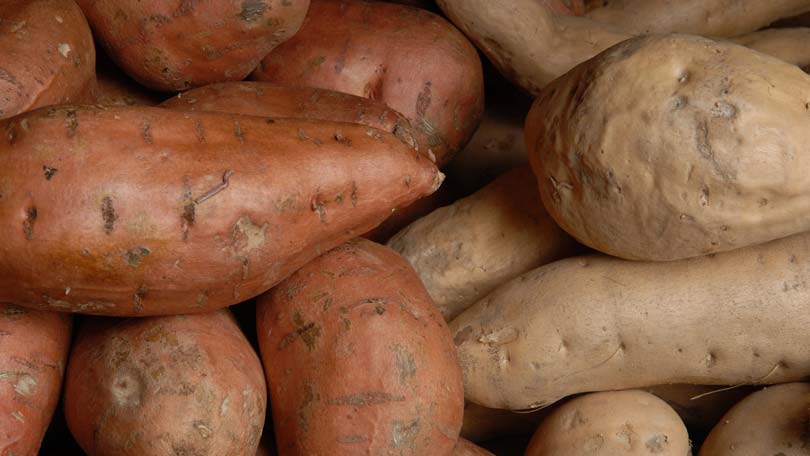
Everyone has heard of them, many have tried them, some even love them. The sweet potato is a rare treat for any potato lover as they usually only see their way onto ones plate no more than a couple of times a year. They pop up when your Aunt brings them over for the Holidays or your mother or grandmother whips up this special dish. For me it is only at times like Thanksgiving, Christmas, and even Easter when their orange glow can be seen on the table. But what are these little darlings? Where do these sweet potatoes come from? And how did they get their name?
Although we refer to them as sweet potatoes, their proper name is Ipomoea batatas, and in reality they are only distantly related to what we know as potatoes (Solanum tuberosu). The sweet potato is a crop plant who’s large, “sweet tasting”, starchy roots tuberous roots give it the standing of an important root vegetable. When you hear talk of “sweet potatoes” in North America, you may here them called a different name, “yams”. When sweet potatoes were introduced to the Southern U.S. decades ago the producers and distributors wanted to distinguish between the orange flesh coloured sweet potatoes and the more traditional white flesh types and so the name “yam” was adopted from an African word that means starchy plant. And the name has stuck every since. However, the “sweet potato” is even more distantly related to the actual yam than it is the potato.
The origin of the sweet potato is similar to that of the potato in that they are both natives of South America. The sweet potato is originally from the tropical Americas and was first domesticated there at least 5,000 years ago. They spread very quickly at this time throughout the region and even into the Caribbean. Previous to Western exploration the sweet potatoes were also present in Polynesia (a grouping of over 1000 islands scattered across the southern and central parts of the Pacific Ocean). How exactly they arrived on these islands has been the subject of a great debate for many years. In today’s age sweet potatoes can now be found being cultivated in tropical and warm temperature regions where there is a sufficient amount of water to support their growth. In North America, North Carolina is the leading state in sweet potato production, providing around 40% of the annual U.S. production of sweet potatoes.
Sweet potatoes are sometimes considered “the small farmers crop” because they are very easy to grow. Although they do not tolerate frost, the sweet potato grows in many farming conditions, they have few natural enemies (pesticides are rarely needed), and they can be grown in poor soil conditions with little fertilizer. They also are easy to plant because they are sown by vine cuttings rather than seedlings and because their rapidly growing vines actually shade out weeds a farmer does not have to spend time weeding them and they can focus on other crops. In tropical areas they can simply be maintained in the ground and then harvested when they are needed to be eaten or sold. Not only does their ability to be grown easily make them popular but also their “sweet” taste and very nutritious elements make sweet potatoes a great food choice. Along with their load of starch sweet potatoes also contain a rich amount of dietary fibre, vitamins A, C, and B6. In 1992, there was a study conducted by the Center for Science in the Public Interest where they compared the nutritional value of other vegetables to the sweet potato. By looking at fibre content, the amount and quality of complex carbohydrates and protein present in each vegetable; and by examining vitamin A, vitamin C, calcium, and iron content the sweet potato was ranked heads above the rest as the most nutritious vegetable. Sweet potatoes with the dark orange flesh that we often accompany with the thought of them or yams are ones with more vitamin A present in them.
There are seven major varieties of sweet potato. These include Jersey, Kotobuki (Japanese), Okinawan (they are purple in colour), Papa Doc, Beauregard, Garnet, and Jewel. These last three listed varieties are the kinds that are often known as “yams” in the United States.
This wraps up the info on the sweet potato and I hope it is all that you have ever wanted to know or will need to know about this great tasting and very nutritious vegetable. After doing my research on this potato I have come to realize that it is not only a special side dish every once in a while at my family holiday gatherings but rather that it is a vegetable that is very good for me and I should start to eat more often. You should consider trying to fit it into your diet more often as well. You know what they say, the more colour in your diet the healthier you will be. Well, I can not think of too many things out there I can eat that are the colour orange, except for oranges of course. So get out there and try some more sweet potatoes, or “yams”, if you will. Here is even a recipe for you to try.
Mashed Sweet Potatoes with Honey
Sweet potatoes are cooked and mashed with honey, brown sugar, butter, and milk, then baked in the oven with marshmallows.
INGREDIENTS:
• 2 cups warm mashed sweet potatoes
• 1/4 teaspoon salt
• 1 tablespoon light brown sugar
• 2 tablespoons honey
• 2 tablespoons butter
• 1/2 cup milk
• 1 cup miniature marshmallows
PREPARATION:
Blend sweet potatoes, salt, brown sugar, honey, butter, and milk. Spoon into a buttered 1-quart casserole. Top with marshmallows. Bake at 350° until marshmallows are browned.
Serves 4.
